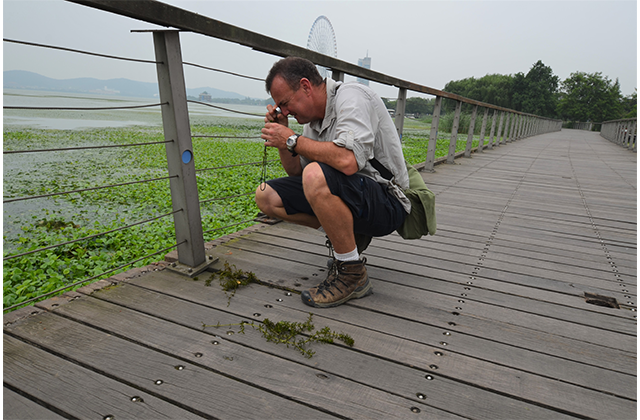The Ongoing Search for New Biological Control Agents of Hydrilla

Hydrilla verticillata, or hydrilla, is a submersed aquatic plant native to Asia, Australia, Europe, and Africa. It is one of the world’s worst weeds. It is a federally listed noxious weed in the U.S. and, after its introduction in the early 1950s, has become widely distributed and highly invasive.
Infestations in the U.S., consisting of both monoecious (male and female flowers on same plant) and dioecious (separate male and female plants) plants, were most likely introduced from the Asia. Hydrilla hinders navigation and irrigation, limits recreation and outcompetes native vegetation that damages natural aquatic ecosystems.
More recently, hydrilla has been implicated in the death of bald eagles due to a neurological condition caused by a toxin produced by a bacterium closely associated with hydrilla. This toxin when consumed, directly or indirectly through the food chain, kills the eagles as well as waterfowl, amphibians, and fish across several U.S. states.
Currently hydrilla is managed in the U.S. using herbicides, mechanical control and/or biological control, but the weed continues to spread, particularly monoecious hydrilla which is moving into the cooler northern regions of the U.S. and threatens the Great Lakes. Unfortunately, herbicide resistance developed and mechanical removal for long-term control is expensive and generally ineffective on a large scale.
Several biological control agents were released in the 1980s and 1990s but only two leaf-mining flies established and only one, Hydrellia pakistanae, has limited impact and only on dioecious hydrilla. These flies are unable to survive the cooler winters, making them ineffective against monoecious hydrilla.
New solutions to control hydrilla are desperately needed to check the continued spread of this invasive weed in U.S. waterways and to mitigate its severe and unwanted impacts.
Since 2013, the Australian Biological Control Laboratory (ABCL) staff in collaboration with the U.S. Army Corps of Engineers, Engineer Research and Development Center (ERDC) surveyed for new biological control agents of hydrilla in South Korea and China, the likely origin of U.S. monoecious hydrilla. ABCL has also been collaborating with the Chinese Academy of Sciences and Henan University in China, as well Hankyong University in the Republic of Korea, to conduct these surveys.
New leaf-mining Hydrellia flies adapted to the U.S. monoecious hydrilla and/or cooler conditions were discovered. ABCL imported and tested one Korean fly from monoecious hydrilla in quarantine in Brisbane, Australia. Unfortunately, it was rejected as a biological control agent given it also fed on two aquatic plant species native to North America. However, other flies from northern China and Korea are yet to be evaluated. Additionally, exploration for new agents is also underway in cooler, unsurveyed regions of southern Australia which are climatically similar to areas of the U.S. where monoecious hydrilla is problematic. It’s hoped that biological control can yet provide sustainable, cost effective and long-term control of hydrilla.

Contact: Matthew Purcell, matthew.purcell@csiro.au
Australian Biological Control Laboratory (ABCL) is based at the Ecosciences Precinct in Brisbane, Australia, and is administered through a Specific Cooperative Agreement between ARS and Australia’s Federal research body, the Commonwealth Scientific and Industrial Research Organisation (CSIRO). The agreement has been a very productive, mutually beneficial, long-term collaborative relationship originating in 1985. Assisting with solving U.S. problems is reciprocated by ARS through supplying Australian scientists with biological control agents from the America’s to control invasive weeds in Australia.
